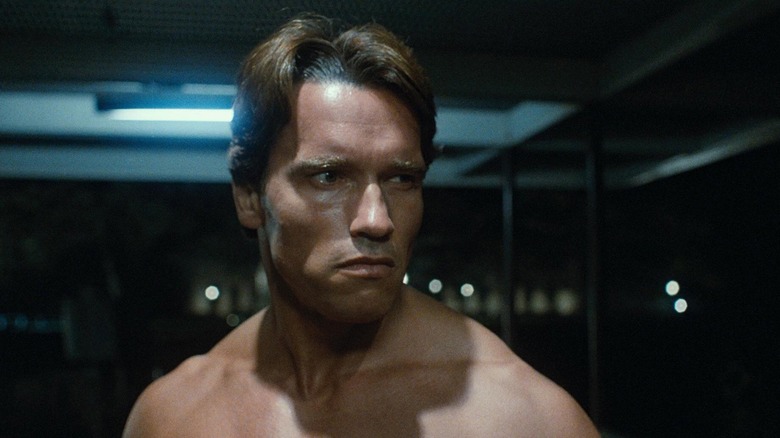James Cameron Used Some Low-Tech Movie Magic To Enhance A Terminator Chase Scene
It's astonishing to think that James Cameron, the mastermind behind FX-laden mega-blockbusters like "Titanic" and "Avatar," once made movies on the cheap. When Cameron made "The Terminator" back in 1984, he was able to assemble relatively low-rent effects to produce some pretty incredible visuals. In one scene, for instance, after actor Arnold Schwarzenegger was briefly on fire, Cameron needed his jacket to realistically smolder. Cameron didn't want to burn Schwarzenegger with anything pyrotechnic, so he threw some (inexpensive) acid onto Arnold's jacket. The dissolving material looked like smoke.
"Terminator" fans might also know the story of how Cameron needed a shot of the killer robot's glowing mechanical eyeball flickering out at the film's conclusion. The achieve the shot, Cameron bought a small red lightbulb at an electronics store, crushed it in between two pieces of styrofoam that he painted silver, and blew cigarette smoke into the frame. He filmed the scene in his garage. The same man who took 13 years to make "Avatar: The Way of Water" was once content with silver styrofoam.
Later in the film, actor Michael Biehn, playing the time-traveling soldier Kyle Reese, rescues the unassuming waitress Sarah Connor (Linda Hamilton) by speeding away from the Terminator in a high speed car chase. The Terminator is so determined to kill Sarah that it clutches onto the front of Kyle's car, punches through the windshield, and tries to grab at Sarah in the process. According to a 2022 oral history in The Ringer, the car chase scene was also a low-rent, seat-of-your pants sequence. Cameron constructed the scene so well, however, that he was apparently able to film it in one take.
The Terminator producer defies audiences to find the fake part of the scene
Schwarzenegger had a stunt double for "The Terminator" of course, but for this car chase scene, Arnold's face appeared on camera, and the actor did some of the dangerous stuff himself (at least in close-ups). Arnold was actually briefly set ablaze, and actually mounted the front of Kyle Reese's car. Biehn remembered how quickly that day of filming went, saying, "[T]he car is screeching backward, Arnold is on fire, and he's smashing his hands in the window of the car and grabbing Linda by her shirt. It's all done in one take."
Co-writer and producer Gale Anne Hurd remembered one of the challenges the filmmakers faced in realizing that sequence, and the brilliant solution Cameron had. Filming a speeding car would have required a closed length of road, a stunt driver, and a stunt performer and cameraman willing to cling onto the back of a vehicle in motion. "The Terminator," made for a modest $6.4 million budget, didn't have the time or the money to utilize all of those things. Instead, a cheaper, more elegant technique was employed. Hurd said:
"That's hard enough as it is. You can control it if the car is stationary. It's dangerous if the car is moving. So Jim said, 'We're going to put a faux-brick wall on the grip truck and drive that past.' And that's how we solved that problem. I defy anyone to look at that shot, given that it's 1984 technology, and think it was anything but a moving car."
She's right. It looks like the car is moving. Here's another interesting piece of trivia about that scene:
Here's a little Terminator trivia tidbit for 'ya.
For this shot they rigged a steel arm to a pneumatic ram under Arnold's jacket and it punched thru the actual car window.
The brick wall was painted on the side of a truck driving past the stationary car. pic.twitter.com/ZwyZlI88cB— Will McCrabb (@mccrabb_will) June 17, 2024
Meanwhile, a third "Avatar" film is due in theaters in 2025, and bears a reported price tag of $250 million. That amount of money might be impressive, but sometimes cineastes idly wish Cameron would go back to the creativity of his low-rent days.
